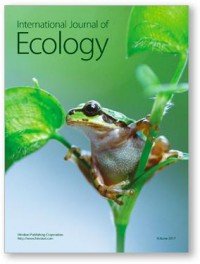International Journal of Ecology Q2
 Unclaimed
Unclaimed
International Journal of Ecology is a peer-reviewed, Open Access journal that publishes original research as well as review articles in all areas of ecological sciences. Articles focusing on behavioral, environmental, evolutionary, and population ecology will be considered, as well new findings relating to biodiversity, conservation, and paleoecology. International Journal of Ecology encourages the submission of big data studies, either presenting novel findings from large datasets or demonstrating new analytical techniques. It has an SJR impact factor of 0,394.
Type: Journal
Type of Copyright: CC BY
Languages: English
Open Access Policy: Open Access
Type of publications:
Publication frecuency: -


697,5 €
Inmediate OANPD
Embargoed OA- €
Non OAMetrics
0,394
SJR Impact factor27
H Index14
Total Docs (Last Year)39
Total Docs (3 years)927
Total Refs55
Total Cites (3 years)39
Citable Docs (3 years)0.97
Cites/Doc (2 years)66.21
Ref/DocOther journals with similar parameters
Contraception: X Q2
Climacteric Q2
Journal of Psychosomatic Obstetrics and Gynaecology Q2
Archives of Gynecology and Obstetrics Q2
European Journal of Obstetrics & Gynecology and Reproductive Biology Q2
Compare this journals
Aims and Scope
Best articles by citations
Effects of Power Lines on Area Use and Behaviour of Semi-Domestic Reindeer in Enclosures
View moreThe Effects of Exurbanization on Bird and Macroinvertebrate Communities in Deciduous Forests on the Cumberland Plateau, Tennessee
View moreForest Structure and the Species Composition of the Parque Estadual Mata Atlantica, Located in Goias State, Brazil
View moreSpatial Variation in Bird Community Composition in Relation to Topographic Gradient and Forest Heterogeneity in a Central Amazonian Rainforest
View moreThe Effect of Timing of Grassland Management on Plant Reproduction
View moreAlien Mink Predation and Colonisation Processes of Rodent Prey on Small Islands of the Baltic Sea: Does Prey Na?Øvete Matter?
View moreSpecies Richness, Community Organization, and Spatiotemporal Distribution of Earthworms in the Pineapple Agroecosystems of Tripura, India
View moreSeasonality of Climate Drives the Number of Tree Hollows in Eastern Australia: Implications of a Changing Climate
View moreDispersal Kernel Determines Symmetry of Spread and Geographical Range for an Insect
View moreChanges in Allometric Attributes and Biomass of Forests and Woodlands across an Altitudinal and Rainfall Gradient: What Are the Implications of Increasing Seasonality due to Anthropogenic Climate Change?
View moreEdge Effects and the Population Structure of Humboldt Bay, California, Eelgrass (Zostera marinaL.)
View moreDo Invasive Fire Ants Affect Habitat Selection within a Small Mammal Community?
View moreThe Fluctuation Niche in Plants
View moreSpecies Turnover across Different Life Stages from Seedlings to Canopy Trees in Swamp Forests of Central Brazil
View moreSemideciduous Seasonal Forest Production of Leaves and Deciduousness in Function of the Water Balance, LAI, and NDVI
View moreMangrove Rehabilitation on Highly Eroded Coastal Shorelines at Samut Sakhon, Thailand
View morePotential Effects of the Loss of Native Grasses on Grassland Invertebrate Diversity in Southeastern Australia
View moreFlower Density Is More Important Than Habitat Type for Increasing Flower Visiting Insect Diversity
View moreUnderstanding the Terrestrial Carbon Cycle: An Ecohydrological Perspective
View moreConservation Concern for the Deteriorating Geographical Range of the Grey Parrot in Cameroon
View moreOf "Host Forms" and Host Races: Terminological Issues in Ecological Speciation
View moreParallel Ecological Speciation in Plants?
View moreImpacts of Bush Encroachment on Wildlife Species Diversity, Composition, and Habitat Preference in Ol Pejeta Conservancy, Laikipia, Kenya
View moreUse of Host-Plant Trait Space by Phytophagous Insects during Host-Associated Differentiation: The Gape-and-Pinch Model
View more
Comments